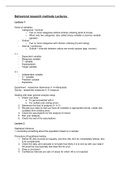Samenvatting
Samenvatting Behavioral Research Methods 2: Dealing With Data (0HV50)
- Instelling
- Technische Universiteit Eindhoven (TUE)
A summary of behavioral research methods 2 with some examples of how to use Stata with the different data. All the stuff you need to know for the exam is in this summary.
[Meer zien]




